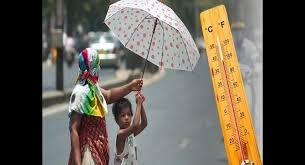Delhi NCR Weather Today 30 May: Intense Heatwave Continues Across Northern India
The weather in Delhi NCR and Northern India has taken a dramatic turn as a severe heatwave grips the region. Temperatures have soared, reaching unprecedented highs. Understanding these weather patterns is crucial for residents to stay safe and manage their daily activities effectively.
The Heatwave Phenomenon
Definition and Causes of Heatwaves
A heatwave is a prolonged period of excessively hot weather, which may be accompanied by high humidity. These conditions are typically caused by high-pressure systems that trap warm air in an area.
Historical Context of Heatwaves in India
India has experienced numerous heatwaves in its history, often resulting in significant impacts on health, agriculture, and daily life. Historically, regions like Rajasthan and Haryana have been particularly susceptible to these extreme weather events.
Current Weather Conditions in Delhi NCR
Temperature Statistics for 30 May
On 30 May, Delhi NCR witnessed temperatures nearing 50 degrees Celsius. This is significantly higher than the average temperatures for this time of year, reflecting the severity of the current heatwave.
Comparison with Previous Years
This year’s heatwave is among the most intense in recent memory. Comparatively, the temperatures recorded this year have surpassed those of previous years, highlighting a worrying trend of increasing heat.
Impact of the Heat on Daily Life
The extreme heat has affected daily activities, with residents finding it challenging to go about their routines. Outdoor activities have been reduced, and the use of air conditioning has surged, leading to increased electricity consumption.
Effects of Extreme Heat
Health Implications
Extreme heat poses serious health risks, including heat exhaustion, heatstroke, and dehydration. Vulnerable groups such as the elderly, children, and those with pre-existing health conditions are particularly at risk.
Environmental Impact
The environment also suffers during heatwaves. Prolonged high temperatures can lead to droughts, affecting water supply and agricultural productivity. Urban areas, in particular, experience the “urban heat island” effect, where concrete and asphalt retain heat.
Economic Consequences
Economically, heatwaves can disrupt productivity, especially in sectors like agriculture and construction. Daily wage workers are often forced to limit their working hours, impacting their earnings.
Weather Extremes Across Northern India
Temperature Records in Haryana and Other States
In Haryana’s Sirsa, the temperature reached a staggering 50.3 degrees Celsius. Other states like Rajasthan, Punjab, and Uttar Pradesh have also reported extremely high temperatures, contributing to the overall heatwave scenario.
Analysis of the Hottest Cities in India
Many cities across India have reported record-breaking temperatures. The continuous monitoring and updating of these records reflect the severity and widespread nature of the heatwave.
Regional Variations in Weather Patterns
While Northern India is the most affected, other regions also experience varying degrees of heat. Coastal areas might have high humidity, exacerbating the discomfort, even if temperatures are slightly lower.
Relief from the Heat
Sudden Weather Changes
On Wednesday evening, Delhi experienced a sudden change in weather. Clouds gathered, and a brief rain shower provided temporary relief from the intense heat.
Brief Respite from Heat in Delhi Due to Rain
The rain brought much-needed respite, cooling the temperatures momentarily and offering a break from the relentless heat.
Impact of Rain on Humidity Levels
However, the rain also increased humidity levels, leading to discomfort as the moisture in the air made it harder for sweat to evaporate, preventing effective cooling of the body.
Delhi’s Weather Forecast
IMD Predictions for the Coming Days
The Indian Meteorological Department (IMD) predicts that the heatwave conditions will persist in Delhi and surrounding areas for the next few days. Residents are advised to take necessary precautions.
Expected Continuation of Heatwave Conditions
Despite the brief rain, the overall weather pattern indicates that the heatwave will continue, with temperatures remaining high.
Tips for Coping with Extreme Heat
To cope with the extreme heat, it’s essential to stay hydrated, wear light and loose-fitting clothing, and avoid strenuous activities during peak heat hours.
Hottest Cities in India
Phalodi, Rajasthan
Phalodi holds the record for one of the highest temperatures ever recorded in India. The city regularly experiences extreme heat during the summer months.
Churu, Rajasthan
Churu is another city in Rajasthan known for its scorching temperatures. It often records temperatures above 50 degrees Celsius.
Barmer, Rajasthan
Barmer’s climate is characterized by extreme heat, making it one of the hottest cities in India during summer.
Jaisalmer, Rajasthan
Known for its desert climate, Jaisalmer often sees temperatures soaring above 45 degrees Celsius, especially in May and June.
Sirsa, Haryana
Sirsa has recently made headlines with temperatures exceeding 50 degrees Celsius, marking it as one of the hottest places in the country.
Bathinda, Punjab
Bathinda experiences intense heatwaves, with temperatures often climbing above 45 degrees Celsius during peak summer.
Delhi
Delhi’s urban heat island effect exacerbates its already high summer temperatures, making it one of the hottest metropolitan areas in India.
Agra, Uttar Pradesh
Agra, famous for the Taj Mahal, is also notorious for its extreme summer heat, with temperatures frequently approaching 50 degrees Celsius.
Aurangabad, Maharashtra
Aurangabad sees significant temperature spikes during summer, often making it into the list of hottest cities.
Gwalior, Madhya Pradesh
Gwalior regularly records high temperatures, contributing to its reputation as one of India’s hottest cities.
Understanding Heatwaves
Scientific Explanation of Heatwaves
Heatwaves occur due to various meteorological factors, including high-pressure systems that prevent heat from dissipating. Climate change has also been linked to the increased frequency and intensity of heatwaves.
Impact of Global Warming
Global warming is contributing to more extreme and prolonged heatwaves. The rise in global temperatures is making heatwaves more common and severe.
Preventive Measures
Staying Hydrated
Drinking plenty of water is crucial to stay hydrated and prevent heat-related illnesses.
Wearing Appropriate Clothing
Light-colored, loose-fitting clothes help keep the body cool by allowing air circulation and reflecting heat.
Avoiding Outdoor Activities During Peak Heat
Limiting outdoor activities during the hottest parts of the day can reduce the risk of heat exhaustion and heatstroke.
Health Advisory
Recognizing Signs of Heatstroke
Symptoms of heatstroke include high body temperature, confusion, nausea, and unconsciousness. Immediate medical attention is essential.
First Aid Tips
If someone shows signs of heatstroke, move them to a cooler place, provide water, and seek medical help immediately.
Importance of Immediate Medical Attention
Prompt medical intervention can be life-saving for individuals suffering from severe heat-related illnesses.
Environmental Impact
Heatwaves and Their Effect on Flora and Fauna
Extreme heat can stress plants and animals, leading to reduced biodiversity and ecosystem
 Suspense Crime Sach Ka Dam
Suspense Crime Sach Ka Dam



